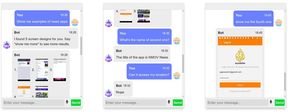New chatbot can explain apps and show you how they access hardware or data

Chatbots have already become a part of our everyday lives with their quick and intuitive way to complete tasks like scheduling and finding information using natural language conversations. Researchers at Aalto University have now harnessed the power of chatbots to help designers and developers develop new apps and allow end users to find information on the apps on their devices.
The chatbot — ‘Hey GUI’ (pronounced goo-ee), short for Graphical User Interface, which will be presented at ACM Designing Interactive Systems 2021 on 1 July — can answer questions by showing images and screenshots of apps, or through simple text phrases.
“Hey GUI eliminates the need for coding skills or technical expertise. Anyone can use it to search for information on, for example, which one of my apps is asking for permission to use the camera, or where is the search button on this screen”, says postdoctoral researcher Kashyap Todi of Aalto University.
Important findings for chatbot developers and researchers
Different kinds of applications and user interfaces contain vast amounts of information, which can be used for different needs and tasks. In their study, the researchers set out to find the most desirable chatbot features and how users would have conversations with them.
Three target groups were considered in the experiment: designers, software developers, and general users. Over 100 designers, developers, and ordinary users responded to the survey.
“Our goal was to get a good understanding of what capabilities and functions different kinds of users would find most beneficial when using this new type of chatbot, as well as how they would formulate questions — especially what kinds of words and phrases they would use. This is an important first step towards developing chatbots that can help users find information about apps using simple conversations”, says Kashyap.
As a result of the survey, 21 key features and more than 1300 of the most common questions put forward by users were collected and analysed to create Hey GUI, allowing users to find information within user interfaces using simple conversations, based on the most frequent expressions collected in the survey.
“Designers can get inspiration, for instance, by asking Hey GUI to find good online shop designs. The chatbot responds with several screenshots from existing apps in the catalogue. Software developers could ask a chatbot what typical colour codes are used for login buttons, and the chatbot responds with several options”, Kashyap adds.
In questions from ordinary users, there was a special emphasis on matters related to privacy and accessibility information, or getting help about their apps, such as asking which apps display maps.
The research prototype is currently under development. The common questions gathered from the survey are available at the website.
The study was conducted in collaboration with the universities of Luxembourg and Bayreuth.
For more information
See the project page.
Read the full article published at ACM DIS 2021.
Watch a short video with a demonstration of the chatbot
or
watch a long video with a demonstration of the chatbot.
Further information:
Kashyap Todi
Postdoctoral researcher, Aalto University, Department of Communications and Networking
kashyap.todi@gmail.com
+358 50 4723 177
Antti Oulasvirta
Professor, Aalto University, Department of Communications and Networking
antti.oulasvirta@aalto.fi
+358 50 3841 561
Finnish Center for Artificial Intelligence
The Finnish Center for Artificial Intelligence FCAI is a research hub initiated by Aalto University, the University of Helsinki, and the Technical Research Centre of Finland VTT. The goal of FCAI is to develop new types of artificial intelligence that can work with humans in complex environments, and help modernize Finnish industry. FCAI is one of the national flagships of the Academy of Finland.

Read more news

Major funding powers development of next-generation machine technology aimed at productivity leap in export sectors
The BEST research project is developing new types of sealing, bearing, and damping technology.
The TAIMI project builds an equal working life – a six-year consortium project seeks solutions to recruitment and skill challenges
Artificial intelligence (AI) is changing skill requirements, the population is aging, and the labor shortage is deepening. Meanwhile, the potential of international experts often remains unused in Finland. These challenges in working life are addressed by the six-year TAIMI project funded by the Strategic Research Council, and implemented by a broad consortium.
Unite! Seed Fund 2026: Call opens on 20 January 2026
Gain an early overview of the Unite! Seed Fund Call of Spring 2026. The call includes three funding lines: Student Activities, Teaching and Learning, and Research and PhD.






